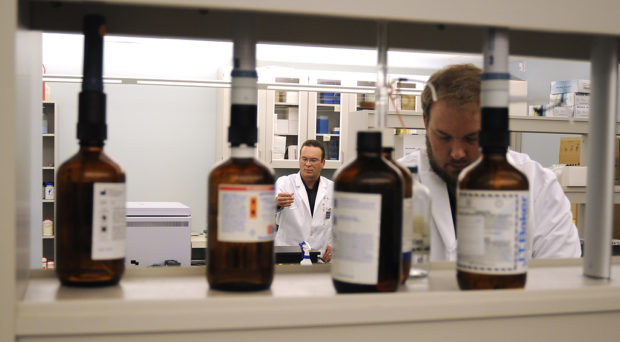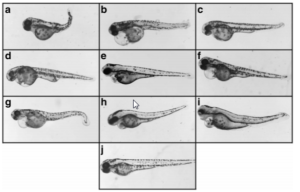
2017 was an exciting year for BMC Pharmacology and Toxicology. We continued to publish some of the most exciting research related to a range of pharmacological and toxicological topics. Throughout the year we published articles on models predicting drug-drug interactions, potential drugs to suppress tumor growth and toxins which adversely impact physiological functioning. Below are three articles from 2017 that we believe deserve extra attention.
Computational modeling can predict adverse drug reactions induced by drug interactions
Medications can cause several adverse drug reactions (ADRs). However, when more than one medication is taken at a time ADRs can increase due to drug-drug interactions.
There are more than 800 drugs on the market, and it is incredibly difficult to track whether there are drug-drug interaction ADRs for specific drug combinations since they either do not exist, have not been reported, or the drug combination has not been taken.
There are more than 800 drugs on the market, and it is incredibly difficult to track whether there are drug-drug interaction ADRs for specific drug combinations since they either do not exist, have not been reported, or the drug combination has not been taken.
Because of these challenges, a recent study by Liu et al. used computational modeling to determine the number and severity of drug-drug interaction ADRs without having to track human patients. For this computational model, the authors utilized the STITCH database, which tracks drug-protein interaction profiles, and TWOSIDES, which tracks ADRs caused by synergistic drug-drug interactions.
The analysis of these databases allowed for the identification of what types of drugs had high and low rates of drug-drug interaction ADRs. Drug classes such as cardiovascular drugs and musculoskeletal drugs were associated with the highest numbers of drug-drug interaction ADRs while antineoplastics (anti-tumor drugs) and immunomodulators were associated with the lowest rates of drug-drug interaction ADRs.
The modeling process also allowed for the calculation of the rates of drug-drug interaction ADRs between two classes of drugs. For example, combining antifungals and proton-pump inhibitors can result in high rates of ADRs.
Furthermore, the modeling predicted the rate of ADRs when combining a drug of one class with drugs of another class. For example, the anti-infectious agent, norfloxacin, had a low adverse drug-drug interaction score when taken with anti-convulsants while a different anti-infectious agent, Nafcillin, had a high adverse drug-drug interaction score when taken with an anti-convulsant.
With the myriad of drugs on the market, this study provides important information for the safety and efficacy of drug prescription.
Exposure to the antimicrobial, triclosan, can decrease the resilience of the mouse gut microbiome

The synergistic relationship between microbiota and an animal is critical for the animal’s health with alterations in the gut potentially leading to health issues. The microbiota can change in response to factors including diet, pesticides and metals.
Triclosan is an antimicrobial that is extensively used in medical and household products such as soaps, cleaning products, and even toothpastes. Worryingly, growing evidence is showing that triclosan may have a negative impact on the gut microbiome.
A study in BMC Pharmacology and Toxicology tested whether triclosan does disrupt the gut microbiome, mice were exposed to water with triclosan or plain water to act as a control. Researchers performed 16s rRNA sequencing to identify the type and number of gut bacteria species during 13 weeks of triclosan exposure.
16S rRNA refers to a specific part of bacteria ribosomal RNA that allows for bacterial species identification. The researchers found that triclosan had a significant impact on both the composition and function of the gut microbiome in the mice.
Of particular importance was the increase in certain bacterial genes which indicated that chronic triclosan exposure was leading to antibacterial resistance. While certain antibacterial resistant genes increased, other gut bacteria decreased.
This combined change in gut bacteria can have detrimental effects for two reasons. First, an increase in antibiotic resistant bacteria can result in a decrease in antibiotic efficacy. Second, a variety of gut bacterial species is important because greater species richness can attenuate any disruptions to the gut microbiome.
This study therefore demonstrates that triclosan can have potential detrimental effects on gut microbiota and repercussions on an animal’s health. More research needs to be done to determine if and what kind of health effects occur as well as whether these findings can be extrapolated to humans.
Methylxanthines alter the structure and function of the cardiac system in zebrafish embryos
Methylxanthines are one of the most commonly ingested substances in the world. They are found in regularly consumed beverages, such as coffee, and are also used medicinally to treat ailments such as asthma, peripheral vascular disease, and obesity.
These data show that a single early exposure of methylxanthines can have toxic effects on body morphology, cardiovascular structures, and cardiovascular functioning.
There is evidence that methylxanthines can be toxic and that this toxicity can start as early as gestation. The authors of this study examined the potential toxic effects on the developing cardiovascular system by using zebrafish, which show a surprisingly similar response to cardiotoxins as mammals.
To test the cardiotoxic effects of methylxanthines, four different doses of eight different methylxanthines were
injected into recently fertilized zebrafish eggs, and the effects of methylxanthines on embryo morphology and cardiovascular structure and functioning were observed at 48 and 72 hours after fertilization.
The highest doses of caffeine, IBMX and pentoxifylline (used for pain in peripheral artery disease) showed the greatest percent of morphological defects in embryos. Cardiovascular structural alterations occurred in 20-40% of embryos when exposed to the highest dose of methylxanthines except for diprophylline and etophylline, two drugs used to treat respiratory diseases.

Five of the methylxanthines also increased heart rate in normal looking embryos at 48 hours after fertilization but returned to normal 24 hours after this. These data show that a single early exposure of methylxanthines can have toxic effects on body morphology, cardiovascular structures, and cardiovascular functioning.
Further research is required to examine whether these effects can translate to higher order species especially to placental mammals since the complex mother-placenta-fetus relationship may prevent certain drugs from passing from the mother to the fetus.
Comments